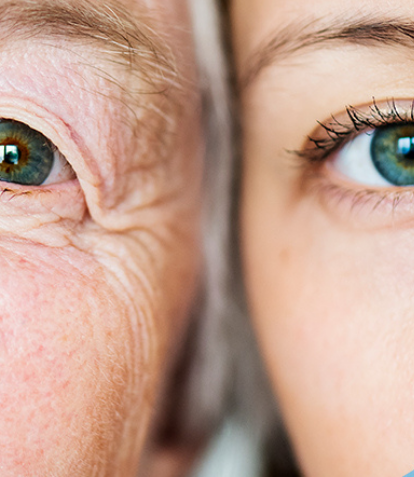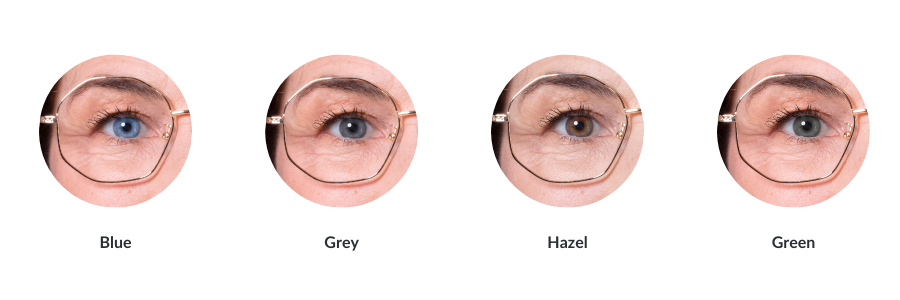

What Is My Eye Colour?
What determines eye colour? It’s a genetic trait, just like our hair and skin. In fact, it’s the same chemical that affects the colour of all three: melanin. The more melanin-producing cells (or melanocytes) you have, the darker your hair, skin and eyes are likely to be. But beyond that, the science of eye colour is rather complicated. Read on to learn more about where your eye colour comes from and how you can change it if you don’t like it.
Different eye colours
The iris is the coloured part of your eye around the pupil. Its colour is due to the amount of melanin in it. The lower the melanin, the bluer the eyes look because more wavelengths of light are reflected. The same applies to green eyes, amber eyes, hazel eyes and every shade in between. These are all caused by varying degrees of melanin. In people with albinism, there is no melanin whatsoever in the eye, and as such, they appear to have red or purple colour eyes: not because they’re reflecting red light, but because we can see the blood in the eyes. This lack of melanin also makes albino eyes highly susceptible to UV, making sunglasses necessary outdoors.

Blue eyes
Did you know blue eyes are not actually blue? Blue eyes do not contain any blue pigment. They appear blue for the same reason the sky does. Light entering the eye is scattered through the iris and perceived as blue because blue is the shortest wavelength of visible light; therefore, more of it is reflected back out. So technically, the eyes themselves are not blue at all.
Grey eyes
Grey eyes are sometimes mistaken for a greyish blue, but studies revealed hints of gold and brown in this eye colour. This type of colour may also appear slightly different depending on clothing, lighting and mood (when the dilation of the pupil compresses the iris).
Hazel eyes
Hazel eyes are mostly made of shades of brown and green. People with hazel eyes often have one colour closest to the pupil, a different one after that and another colour ring around the edge of the iris. Depending on the lighting, this type of eye may appear more brown than green and vice versa.
Green eyes
Green is the least common eye colour. This is because green eyes only occur when a specific set of genes is combined with a specific amount of melanin. This eye colour is found most frequently in Northern and Central Europe.
What is the most common eye colour?
Brown eyes are by far the most common worldwide, and in many areas of the world, such as East Asia and Sub-Saharan Africa, it’s rare to find any other colour. That’s because brown is a “dominant” gene, so any child of brown and non-brown-eyed parents is much more likely (though not certain) to have brown eyes too. There is no confirmed advantage of having brown eyes, but research has indicated that they may be slightly better at absorbing bright light and blocking UV rays.
What is the rarest eye colour?
The rarest eye colour is green. If you have this eye colour, consider yourself among the rarer population; only 2% of people worldwide have green eyes.
Can eyes change colour?
Even if you’re born with blue, grey or green eyes, there’s no guarantee you’ll keep them throughout your life. The melanin-producing cells in your eyes may only become active after a few months or years and, in rare cases, even longer. When this happens, brown pigment will start to be created, leading to darker eyes.
If, for whatever reason, you want to have a different eye colour, what you can do is wear coloured contacts. These are available in both prescription and plano forms. In any case, coloured contact lenses are medical devices, so you will need a valid eye prescription from a licensed optician before buying your first pair. Even if you want plano lenses, you must visit a vision specialist beforehand and have them write you a prescription specifically for wearing coloured contacts. Learn more about coloured contacts at SmartBuyGlasses’ Optical Center.
What Is My Eye Colour?
What determines eye colour? It’s a genetic trait, just like our hair and skin. In fact, it’s the same chemical that affects the colour of all three: melanin. The more melanin-producing cells (or melanocytes) you have, the darker your hair, skin and eyes are likely to be. But beyond that, the science of eye colour is rather complicated. Read on to learn more about where your eye colour comes from and how you can change it if you don’t like it.
Different eye colours
The iris is the coloured part of your eye around the pupil. Its colour is due to the amount of melanin in it. The lower the melanin, the bluer the eyes look because more wavelengths of light are reflected. The same applies to green eyes, amber eyes, hazel eyes and every shade in between. These are all caused by varying degrees of melanin. In people with albinism, there is no melanin whatsoever in the eye, and as such, they appear to have red or purple colour eyes: not because they’re reflecting red light, but because we can see the blood in the eyes. This lack of melanin also makes albino eyes highly susceptible to UV, making sunglasses necessary outdoors.

Blue eyes
Did you know blue eyes are not actually blue? Blue eyes do not contain any blue pigment. They appear blue for the same reason the sky does. Light entering the eye is scattered through the iris and perceived as blue because blue is the shortest wavelength of visible light; therefore, more of it is reflected back out. So technically, the eyes themselves are not blue at all.
Grey eyes
Grey eyes are sometimes mistaken for a greyish blue, but studies revealed hints of gold and brown in this eye colour. This type of colour may also appear slightly different depending on clothing, lighting and mood (when the dilation of the pupil compresses the iris).
Hazel eyes
Hazel eyes are mostly made of shades of brown and green. People with hazel eyes often have one colour closest to the pupil, a different one after that and another colour ring around the edge of the iris. Depending on the lighting, this type of eye may appear more brown than green and vice versa.
Green eyes
Green is the least common eye colour. This is because green eyes only occur when a specific set of genes is combined with a specific amount of melanin. This eye colour is found most frequently in Northern and Central Europe.
What is the most common eye colour?
Brown eyes are by far the most common worldwide, and in many areas of the world, such as East Asia and Sub-Saharan Africa, it’s rare to find any other colour. That’s because brown is a “dominant” gene, so any child of brown and non-brown-eyed parents is much more likely (though not certain) to have brown eyes too. There is no confirmed advantage of having brown eyes, but research has indicated that they may be slightly better at absorbing bright light and blocking UV rays.
What is the rarest eye colour?
The rarest eye colour is green. If you have this eye colour, consider yourself among the rarer population; only 2% of people worldwide have green eyes.
Can eyes change colour?
Even if you’re born with blue, grey or green eyes, there’s no guarantee you’ll keep them throughout your life. The melanin-producing cells in your eyes may only become active after a few months or years and, in rare cases, even longer. When this happens, brown pigment will start to be created, leading to darker eyes.
If, for whatever reason, you want to have a different eye colour, what you can do is wear coloured contacts. These are available in both prescription and plano forms. In any case, coloured contact lenses are medical devices, so you will need a valid eye prescription from a licensed optician before buying your first pair. Even if you want plano lenses, you must visit a vision specialist beforehand and have them write you a prescription specifically for wearing coloured contacts. Learn more about coloured contacts at SmartBuyGlasses’ Optical Center.







































